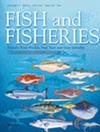利用声学遥测技术揭示水生物种的生物钟
IF 6.1
1区 农林科学
Q1 FISHERIES
引用次数: 0
摘要
声学遥测技术提供了宝贵的机会来研究与昼夜节律相关的个体差异和其他行为,以及环境线索如何在野生鱼类种群中塑造这些模式。然而,这一潜力尚未得到充分利用。我们对来自34种不同海洋和淡水物种的44个数据集以及不同类型的数据(声学探测、深度、加速度和定位)进行了meta分析。我们的目的是探索声学遥测技术在识别昼夜节律相关行为中个体差异一致的时型方面的潜力。首先,我们使用隐半马尔可夫模型将单个时间序列分为活动状态和休息状态。随后,我们计算了两个经典的与昼夜节律相关的行为特征:觉醒时间(作为活动开始)和休息时间(作为活动抵消)。随后,我们根据可重复性评分将行为变异分解为个体内部和个体之间的成分,从而确定了不同的表型。我们在17种水生物种中发现了不同的睡眠类型的证据,觉醒时间的平均重复性得分为0.52,休息时间的平均重复性得分为0.43,这表明睡眠类型在水生物种中是常见的。我们的研究结果强调,数据类型(尤其是加速度传感器)和检测数量都是探索生物钟类型的有效工具。我们的研究提出了一种描述水生物种(主要是鱼类)日常活动模式的新方法,并为研究不同分类群的时型提供了指导。我们强调生物遥测技术和先进的统计模型的前景,以提高我们对水生物种行为的理解,并强调在生物遥测项目网络中收集的大型数据集的综合价值。本文章由计算机程序翻译,如有差异,请以英文原文为准。
Revealing Chronotypes Across Aquatic Species Using Acoustic Telemetry
Acoustic telemetry offers valuable opportunities to investigate individual variability in circadian‐related and other behaviours and how environmental cues shape these patterns in wild fish populations. However, this potential has not yet been fully exploited. We conducted a meta‐analysis on 44 datasets from 34 distinct marine and freshwater species and different types of data (acoustic detections, depth, acceleration and positioning). Our aim was to explore the potential of acoustic telemetry in identifying chronotypes as consistent among‐individual differences in circadian‐related behaviours. First, we applied hidden semi‐Markov models to classify individual time series into active and rest states. Subsequently, we computed two classical circadian‐related behavioural traits: awakening time (as the activity onset) and rest onset (as the activity offset). Subsequently, we identified distinct phenotypes by decomposing behavioural variation into within‐ and among‐individual components based on repeatability scores. We found evidence of distinct chronotypes in 17 species, with average repeatability scores of 0.52 for awakening time and 0.43 for rest onset, revealing that chronotypes are common in aquatic species. Our findings highlight that both the data type, particularly acceleration sensors, and the number of detections are effective tools for exploring chronotypes. Our study proposes a novel approach to characterising daily activity patterns in aquatic species, predominantly in fishes, and provides guidelines for investigating chronotypes across diverse taxa. We emphasise the promise of biotelemetry and advanced statistical models for improving our understanding of the behaviour of aquatic species and highlight the value of synthesising across large data sets collected in networks of biotelemetryprojects.
求助全文
通过发布文献求助,成功后即可免费获取论文全文。
去求助
来源期刊

Fish and Fisheries
农林科学-渔业
CiteScore
12.80
自引率
6.00%
发文量
83
期刊介绍:
Fish and Fisheries adopts a broad, interdisciplinary approach to the subject of fish biology and fisheries. It draws contributions in the form of major synoptic papers and syntheses or meta-analyses that lay out new approaches, re-examine existing findings, methods or theory, and discuss papers and commentaries from diverse areas. Focal areas include fish palaeontology, molecular biology and ecology, genetics, biochemistry, physiology, ecology, behaviour, evolutionary studies, conservation, assessment, population dynamics, mathematical modelling, ecosystem analysis and the social, economic and policy aspects of fisheries where they are grounded in a scientific approach. A paper in Fish and Fisheries must draw upon all key elements of the existing literature on a topic, normally have a broad geographic and/or taxonomic scope, and provide general points which make it compelling to a wide range of readers whatever their geographical location. So, in short, we aim to publish articles that make syntheses of old or synoptic, long-term or spatially widespread data, introduce or consolidate fresh concepts or theory, or, in the Ghoti section, briefly justify preliminary, new synoptic ideas. Please note that authors of submissions not meeting this mandate will be directed to the appropriate primary literature.
 求助内容:
求助内容: 应助结果提醒方式:
应助结果提醒方式:


